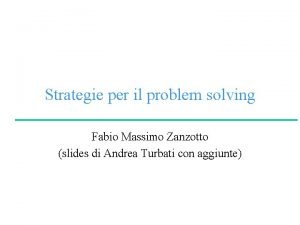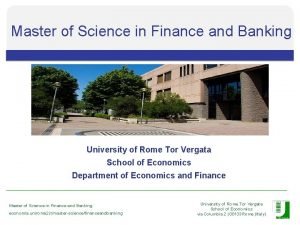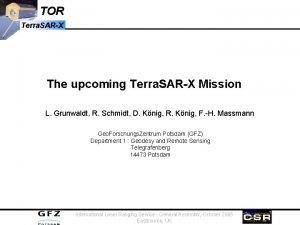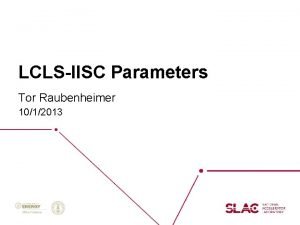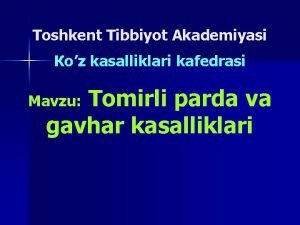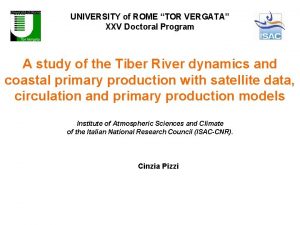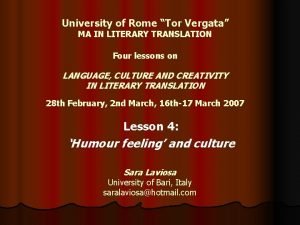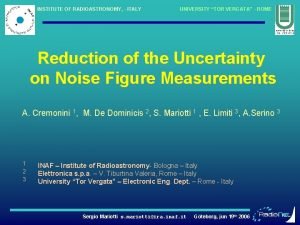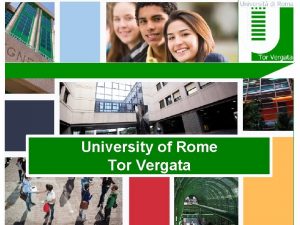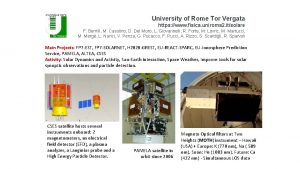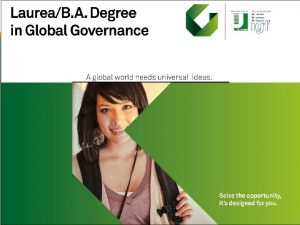0 1 Who are we Tor Vergata Rome













- Slides: 13

0

1 Who are we? Tor Vergata ( «Rome 2» ) is in the south-eastern part of Rome, Italy, 35 minutes away from the center of the city. 39. 000 students. 6 Faculties: Arts and Philosophy, Economics, Engineering, Law, Medicine, Sciences. Born 30 years go, our University is ranked 33 rd in the world ranking in QS World’s Top 50 under 50 - the only Italian University present in it.

2 High international focus Overseas Programme: scholarships for Latin America, USA, Japan More than 250 fellowships: for a minimum period of 6 months abroad in 75 partner universities. Erasmus Placement: fellowships for stages abroad Progetto Leonardo: fellowships for theses abroad

3 Degree courses taught in English (no Law) School of Science -M. Sc. in Physics for Instrumentation and Technology -M. Sc. in Astrophysics -M. Sc. in Biotechnology School of Engineering - Bach. Engineering Sciences - M. Sc. in ICT and Internet Engineering School of Medicine (+Hospital) - 6 year degree in Medicine and Surgery -M. Sc. in Physical Activities and Health Promotion School of Economics -Bach. in Global Governance -Bach. in Business Administration -Bach. In Business and Economics - M. Sc. in Business Administration - M. Sc. in Economics - M. Sc. in European Economy and Business Law - M. Sc. in Finance School of Arts and Philosophy - M. A. in European History in collaboration with Université Paris Diderot, Humboldt-Universität zu Berlin, University College Dublin, Università Rome Tre, King’s College London School of Pharmacy 5 -year degree in collaboration with University of Nottingham and Alliance Boots

4 Global Governance Curriculum 1 st year: § Legal Traditions and Comparative Law § Global Economics § Calculus § History and Civilizations § Foundations of European Thought § Natural Disasters Prevention and Reaction § Plants and Environment 2 nd year: § Political Systems § Statistical Tools for Decision-making § Global Management § International Relations § Global Society and New Media § Health Management § Global Law 3 rd year: § Conflict Management and Negotiations § Applied English: Speech and Performance § Quality Control Assessment § Anthropology of Globalization § Comparative Business History …Choose your specialization! Six mini-specializations: § § § Geo-Economics Geo-Politics Geo-Flows International Law Business Cybersecurity and Big Data

5 Global Governance. . . and more Programme Office dedicated to you Personal Advisor (Professor) Each student meets monthly with a personal advisor for the whole duration of the course Global Conversations Seminars and meetings with international leaders, public and private Team Building and Communication Skills Courses Institutional Visits Mandatory Attendance and Code of Conduct International Visiting Professors Web: www. g lobalg overn ance. i t Coord inator Pr Conta cts: of. G Secre ustavo Pig te a Patriz riat ia globa Marta l. gove rnanc +39 e@un iroma 06 725 2. it 95512 - 5823

6 Global Law (2 nd year) ☞ The Course is divided into four Modules: ☞ I. Global Administrative Law (Prof. Della Cananea) ☞ II. The International protection of Cultural Heritage and the Environment (Prof. Mucci) ☞ III. Self-Determination and Minorities: Contemporary Issues in International and European Law (Prof. Simone) ☞ IV. International Economic Law (Prof. Borgia)

7 The International Protection of Cultural Heritage and the Environment ☞ Basic principles underlying the protection of cultural heritage and the environment in the international legal order ☞ ☞ Heritage, environment and human rights: Cultural heritage as a common heritage of humankind and the environment as a common concern of humankind The so-called “third generation” human rights Environmentally and culturally sustainable development: a challenge, an opportunity ☞ ☞ ☞ Heritage and peace: The first international rules about cultural heritage in the law of armed conflicts banning pillage and voluntary attack The restitution of illegally removed cultural properties as a condition for restoring peace and security in the UN Security Council decisions

8 The International Protection of Cultural Heritage and the Environment ☞ The UNESCO conventional system for the protection of cultural heritage: solution of jurisdictional problems and creation of systems of shared responsibility ☞ Obligations of safeguard and of respect: the 1954 The Hague Convention for the protection of cultural property in the event of armed conflict and its two Protocols Cultural nationalism v. cultural universalism? The 1970 Paris Convention on the means of prohibiting and preventing the illicit import, export and transfer of ownwership of cultural property A specific protection for sites “of outstanding universal value”: the 1972 Paris Convention concerning the protection of the world cultural and natural heritage Granting protection to “the widest – submerged – museum of the world”: the 2001 Paris Convention on the protection of the underwater cultural heritage Beyond the “classic” heritage concept: the 2003 Paris Convention for the safeguarding of the intangible cultural heritage Cultural diversity as essential as biodiversity, to be protected in a globalised world: the 2005 Paris Convention on the protection and promotion of the diversity of cultural expression ☞ ☞ ☞

9 The International Protection of Cultural Heritage and the Environment ☞ Protection based on specific general international law rules, a process in the making ☞ �The already established prohibition of the pillage of cultural properties during armed conflicts �The 2003 UNESCO Declaration and international practice concerning the intentional destruction of cultural heritage �The 2001 UNESCO Declaration affirming that cultural diversity is a common heritage of humanity ☞ ☞

10 ☞ ☞ ☞ The international protection of the environment: guiding principles and conventional framework o From transboundary harm to global asset approach (1972 Stockholm Declaration on Human Environment, 1992 Rio Declaration on Environment and Development) o The conventional framework: from the 1909 Boundary Waters Treaty to the 1997 Kyoto Protocol to the UN Framework Convention on Climate Change o The polluter-pays principle, the prevention principle, the precautionary principle and the duty to do environmental impact assessment o The 1998 Aarhus Convention and the development of procedural rights in the environmental context

11 The International Protection of Cultural Heritage and the Environment ☞ ☞ Complementarity of the international and domestic level of protection o The necessary voluntary engagement of the State on whose territory the cultural property or the natural site/endangered species is localized “Soft means of coercive implementation” to grant best effectiveness of protection Selected materials are distributed to the students during the course. Some suggested readings are available in electronic form. General Reference Textbooks: Craig Forrest, International law and the protection of cultural heritage, Routledge, November 2010, ISBN: 978 -0 -415 -46781 -0, 458 pp. Ved P. Nanda, George (Rock) Pring, International Environmental Law and Policy for the 21 st Century, Brill/Nijhoff, 2 nd Revised Edition, ISBN 13: 9789004242869; EISBN: 9789004250239, Publication Date: October 2012, Copyright Year: 2013, Format: Hardback, 668 pp.

12 Ideas for joint research projects ☞ ☞ European Commission ERASMUS + Key action II – Capacity building in the field of higher education ☞ • This action aims to support the modernisation, accessibility and internationalisation of higher education in the Partner Countries. Among the activities supported under this action, Joint Projects may typically carry out a wide range of activities, such as: development, testing and adaptation of 1. curricula, courses, learning materials and tools 2. learning and teaching methodologies and pedagogical approaches, especially those delivering key competences and basic skills, language skills, entrepreneurship education and focusing on the use of ICT. To work on the development of a joint MA Degree in Global Governance and other projects of common interest • Deadline for the application: 10 February 2016 for projects starting 15 October of the same year • Consortia must include at least as many Partner Country HEIs as there are Programme Country HEIs. At least one eligible Partner Country must be involved in the project. If the project involves more than one eligible Partner Country, these countries can be from the same region or from different regions covered by the Action. Projects involving partners from Region 4 (Russian Federation) must involve at least another Partner Country. Minimum two HEIs from each of the eligible Partner Countries taking part in the project. In Partner Countries where the number of higher education institutions is lower than 5 or in cases where one single institution represents more than 50% of the overall student population of the country, a derogation to the rule will be applied and applications counting only one HEI for those countries will be accepted. At least three Programme Countries with minimum one HEI from each of the Programme Countries taking part in the project. ☞ ☞ ☞
 Master business administration tor vergata
Master business administration tor vergata Infn roma tor vergata
Infn roma tor vergata Vqr tor vergata
Vqr tor vergata Simone bozzato
Simone bozzato Master of science in business administration tor vergata
Master of science in business administration tor vergata Fabio massimo zanzotto
Fabio massimo zanzotto Davide lauro
Davide lauro Msc finance and banking tor vergata
Msc finance and banking tor vergata Roma school of economics (tor vergata)
Roma school of economics (tor vergata) Valeria conte tor vergata
Valeria conte tor vergata Antigentest åre
Antigentest åre Terra tor
Terra tor Tor raubenheimer
Tor raubenheimer Tor parda kasalliklari
Tor parda kasalliklari





